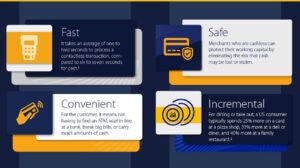While many coffee shops have gone cashless, cashless froyo shops are much rarer, though they do exist. A Yogurtland location in Denver went cashless after multiple robberies in 2020. A Menchie’s in downtown Washington DC went cashless early, since 2018 or earlier. Front Porch in Round Rock, Texas is also a cashless froyo shop. Yoga-urt, which has locations in Glendale, Santa Monica, and Echo Park (Los Angeles), California, went cashless and contactless during the pandemic and is still cashless. Yogurtland in South Africa announced it would go cashless from March 13, 2023 “because it’s quicker, cleaner, and safer for you and our staff.”
Cashless businesses do not accept cash; customers pay with a credit or debit card or with smartphone payment apps. During the COVID-19 pandemic, many restaurants went cashless with the shift to online ordering, delivery, and takeout. Contactless transactions were deemed safer for customers and employees. Even previously cash only restaurants started accepting credit cards. The trend towards cashless restaurants started before the pandemic, accelerated due to the pandemic, and is expected to continue to grow. According to a report from PwC, “global cashless payment volumes are set to increase by more than 80% from 2020 to 2025, from about 1tn transactions to almost 1.9tn.”
Froyo Shop Owners Share Their Thoughts on Going Cashless
When asked about cashless transactions, Ariel Ford, who owns five Easy Breezy Frozen Yogurt shops in the San Francisco Bay Area, says it isn’t right for her businesses because “over 40% of our transactions are cash and over half of our customers are kids.” She also pointed out when a POS system goes down, they accept cash only “until we get the system going again. That alone is thousands of dollars in cash a year, sometimes more.” She does offer a variety of cashless and contactless payment options.
Melissa Schulman, owner of Yoga-urt, says all three of her stores in the Los Angeles area are now cashless and she’s unlikely go back because she had to deal with internal theft when they accepted cash and it takes a lot of her time to “count all of the money, go to the bank, get change, etc.” with three shops. Now that the shops are cashless, that’s not an issue. She feels that 90% – 95% are fine with the cashless policy. As for advice, if she runs into someone who has cash and no other form of payment, she’ll offer to take the cash and pay on her credit card. She had a team member do that as well. Melissa adds that it is possible to go cashless. “You may lose some customers but I don’t think too many. And ultimately, you have to do what is right for you and your store.”
Ryan Piscovich of Yogurt Park in Berkeley, California, sees the advantages of cashless transactions despite the fact that Yogurt Park was cash only for 36 years. He says that during the UC Berkeley school year, “about 80% of payments are cashless. That percentage is more cash-heavy when school isn’t in session.” He sees cashless transactions as “easier and faster.” He explains that with cash, you have to make sure you have change, the cashier may provide incorrect change, there is a risk of theft, and it takes time to go to the bank. Cashless payments are faster and allow them to sell more froyo. Sometimes they sell 120 – 150 cups of froyo an hour, so transaction speed matters. However, they haven’t gone cashless because his father, Marty, who founded Yogurt Park in 1977, is concerned about alienating his regulars and kids without credit cards or payment apps. The older customers who come regularly are more likely to pay with cash.
Advantages of Cashless Businesses
The key advantages of becoming a cashless business are safety, time and space savings, improved transaction accuracy, larger transactions, higher tips for employees, lower insurance rates, and added convenience for people who don’t have enough cash on hand.
Safety: Running a business without keeping cash on the premises reduces the risk of being robbed.
Time & space savings: Transaction time matters to froyo shop customers because froyo melts quickly. Paying with a card or app is faster than paying with cash. The customer spends less time looking and counting cash and the cashier spends less time counting cash and making change. This allows for more transactions per hour and reduces the amount of time that customers wait in line. Contactless payments made by tapping a contactless chip card, mobile device or wearable device over a contactless-enabled payment terminal make it faster to pay. They can also improve the checkout experience and improve customer satisfaction.
Managers also save time on cash management, including counting bills, reconciling cash on hand, and making trips to the bank. For some restaurants, freeing up time from cash management makes up for the higher transaction costs of not accepting cash.
Cashless businesses do not need large cash drawers, so there’s more room for other items on the counter.
Improved accuracy and reduced risk of employee theft: By eliminating the need to make change, cashless businesses reduce loss due to human errors and employee theft. Transactions and tips are also easier to track when customers pay with card or phone app. This also reduces the chance of being audited.
Greater convenience for people who don’t carry cash or have enough cash on hand: According to Pew Research Center in 2022, 54% of those under 50 don’t worry about having cash on hand vs. 28% of those over 50. Also, 41% of Americans typically do not pay in cash in a typical week while 14% make most or all of their purchases in cash. In 2018, these numbers were 29% and 18% respectively. Pew Research Center also found that those paying with cash tended to be lower income, black, and Hispanic and those who do not pay in cash tended to be white and higher income.
Lower insurance rates: Some restaurants have mentioned that they pay less insurance by operating as a cashless business. If a business accepts cash, insurance companies require safes that meet their requirements.
Encourage larger transactions: According to a study commissioned by VISA, people who pay with a credit card spend more than those paying with cash. For example, those paying with a card spent 25% more at pizza shops than those paying with cash.
Higher tips for employees: It’s been shown that people are more likely to tip when they pay with a card or phone app than with cash. This is because technology is being used to remind people to tip and paying electronically is psychologically less painful. When reminded electronically to tip, people can experience guilt if they don’t tip.
Disadvantages of Cashless Businesses
On the other hand, cashless businesses have certain disadvantages, including making transactions more difficult for the unbanked/underbanked population and those who prefer to pay with cash, higher transaction fees, and vulnerability to hacking and technology related problems. In some areas, cashless businesses have been banned.
Inconveniencing the unbanked/underbanked population: According to the Federal Deposit Insurance Corporation (FDIC) 2021 survey, the percentage of US households without a checking or savings account (aka, unbanked) is at an all-time low of 4.5% or 5.9 million households. The unbanked rates are higher for black and Hispanic households (compared to white households). Going cashless disproportionately inconveniences the unbanked, including the unhoused, undocumented, and low income. Some consider cashless policies to be racist.
Alienating those who want to pay with cash: Some people prefer to pay with cash, particularly for small purchases, and may feel alienated if your business does not accept cash. Some people prefer the anonymity of paying with cash or are too young to own a credit or debit card.
Higher transaction fees for credit/debit card transactions compared to cash: These fees typically range from 1% to 4% per transaction.
Risk of hacking and problems with technology: Transactions and customer data can be hacked. Data breaches are hardly uncommon and have happened to large companies like DoorDash, Dunkin’, Panera, and Chipotle. Problems with the internet, apps and credit card processing can make it challenging if not impossible to accept electronic payments. Ensuring that data is encrypted and using a POS that can operate offline can help mitigate these risks.
Cashless bans in certain areas: Some cities and states have outlawed cashless businesses, including New York City, San Francisco, Philadelphia, Massachusetts, Rhode Island, and New Jersey.
Tips for Going Cashless
If you are thinking about going cashless, our merchant services partner, Green Payment Solutions, offers the following advice, “There are two important first steps to transitioning to cashless. 1. Audit the payment types your customers are paying with, 2. Review the cost of your credit card processing account. Make sure you are paying the lowest possible rate available. As partners with the IFYA, we want to show you how much money you could be saving currently. Cashless payments are growing quickly and a business owner can rely on us to protect their savings potential in this increasingly digital world.”
Businesses that operate in urban areas and have a customer base that skews younger and more affluent are good candidates for going cashless. If few of your current transactions are paid for with cash, your risk of alienating customers by not accepting cash is reduced.
Having clear signs about your cashless policy helps avoid awkward situations. Place one by the register, near the froyo cups (for self-serve froyo businesses) and another near the entrance. We were surprised to find our local Dunkin went cashless but it had clear signs all over the store.
Offer other payment options. Prepaid cards, gift cards, and loyalty cards and apps offer customers other options should they not have a credit or debit card.
Have a backup plan. If someone can only pay in cash, provide your employees with a clear process for dealing with the situation.
Train employees about the risks of cashless payments. Customers may be concerned about sharing their personal information. Learn about the security of your payment processing and share that information with employees. They’ll be better able to answer customer questions about cybersecurity.





